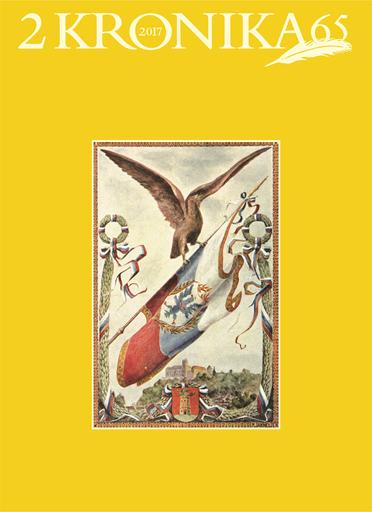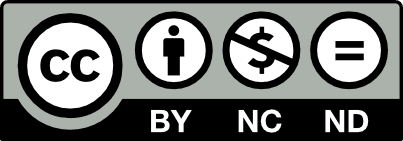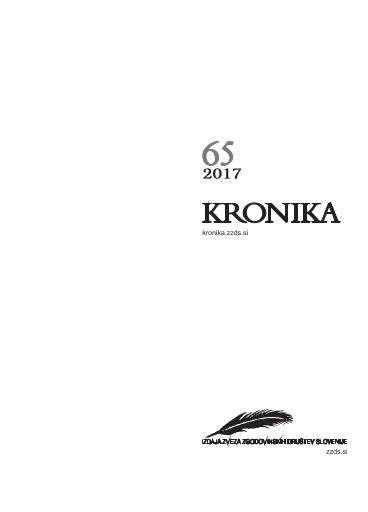/
Serijske publikacije
/
Kronika: časopis za slovensko krajevno zgodovino
Družbena podoba Ljubljane v letih 1945–1965

Avtor(ji):David Petelin
Soavtor(ji):Miha Prainfalk (ur.), Barbara Šterbenc Svetina (teh. ur.), Manca Gašperšič (prev.), Rok Janežič (lekt.)
Leto:2017
Založnik(i):Zveza zgodovinskih društev Slovenije, Ljubljana
Vir(i):Kronika, 2017, št. 2
Jezik(i):slovenščina
Vrst(e) gradiva:besedilo
Ključne besede:Ljubljana, 1945–1965, prebivalstvena struktura, demografija, socioekonomske razmere, družbena podoba, Ljubljana, 1945–1965, population structure, demography, socio-economic conditions, social image
Avtorske pravice:

To delo avtorja David Petelin je ponujeno pod Creative Commons Priznanje avtorstva-Nekomercialno-Brez predelav 4.0 Mednarodna
Datoteke (1)

Ime:Kronika_2017-2-low.pdf
Velikost:5.66MB
Format:application/pdf
Stalna povezava:https://hdl.handle.net/11686/file25900
Opis
During the first two decades after the Second World War, Ljubljana experienced drastic economic and social changes. The main objective of the socialist revolutionary social transformation was the abolition of social classes and inequality, which enabled the improvement in the living standard and a gradual elimination of lower social strata. The social and socio-economic composition of the population, on the other hand, was accompanied by demographic changes. According to the population census, Ljubljana had 59,765 inhabitants in 1931, 79,050 in 1939, 88,695
on the occupation in 1941, and 96,865 at the end of the war, i.e., on 15 July 1945. The city had 115,095 permanent residents in the population census of 15 March 1948. As evident from the census of 1953, Ljubljana’s population grew to 138,981. In 1961, the number of inhabitants in the area of present-day City of Ljubljana rose to 170,505 and surpassed the 200,000 mark in the population census of 1971.
Metapodatki (12)
- identifikatorhttps://hdl.handle.net/11686/44594
- naslov
- Družbena podoba Ljubljane v letih 1945–1965
- Social Image of Ljubljana in 1945–1965
- avtor
- David Petelin
- soavtor
- Miha Prainfalk (ur.)
- Barbara Šterbenc Svetina (teh. ur.)
- Manca Gašperšič (prev.)
- Rok Janežič (lekt.)
- predmet
- Ljubljana
- 1945–1965
- prebivalstvena struktura
- demografija
- socioekonomske razmere
- družbena podoba
- Ljubljana
- 1945–1965
- population structure
- demography
- socio-economic conditions
- social image
- opis
- Ljubljana je v prvih dveh desetletjih po drugi svetovni vojni doživela korenite gospodarske in družbene spremembe. Osrednji cilj socialistične revolucionarne družbene preobrazbe je bila odprava družbenih razredov in socialne neenakosti, ki je omogočila izboljšanje življenjskega standarda ter postopno izginotje nižjih socialnih slojev. Družbeno in socioekonomsko podobo prebivalstva pa so spremljale demografske spremembe. Ljubljana je imela po popisu leta 1931 59.765, leta 1939 79.050, ob okupaciji leta 1941 88.695, ob koncu vojne 15. julija 1945 pa že 96.865 prebivalcev. Po ljudskem štetju 15. marca 1948 je bilo v mestu 115.095 stalnih prebivalcev. Popis iz leta 1953 kaže, da je prebivalstvo Ljubljane naraslo na 138.981. Število prebivalcev na območju današnje Mestne občine Ljubljana se je leta 1961 povzpelo na 170.505, po štetju leta 1971 pa preseže mejo 200.000.
- During the first two decades after the Second World War, Ljubljana experienced drastic economic and social changes. The main objective of the socialist revolutionary social transformation was the abolition of social classes and inequality, which enabled the improvement in the living standard and a gradual elimination of lower social strata. The social and socio-economic composition of the population, on the other hand, was accompanied by demographic changes. According to the population census, Ljubljana had 59,765 inhabitants in 1931, 79,050 in 1939, 88,695 on the occupation in 1941, and 96,865 at the end of the war, i.e., on 15 July 1945. The city had 115,095 permanent residents in the population census of 15 March 1948. As evident from the census of 1953, Ljubljana’s population grew to 138,981. In 1961, the number of inhabitants in the area of present-day City of Ljubljana rose to 170,505 and surpassed the 200,000 mark in the population census of 1971.
- založnik
- Zveza zgodovinskih društev Slovenije
- datum
- 2017
- 01. 01. 2017
- tip
- besedilo
- jezik
- Slovenščina
- jeDelOd
- pravice
- licenca: ccByNcNd
